Biomaterials in Concrete for Engineering Applications: A Bibliometric Review
Abstract
:1. Introduction
1.1. Background
1.2. Literature Review
1.3. General Aspects
- Biomaterials in Construction: Biomaterials are substances derived from organic sources, such as agricultural waste, byproducts, or even living organisms like fungi and bacteria. In recent years, researchers and engineers have explored their potential use in various construction applications to reduce the environmental impact of traditional building materials.
- Sustainability: One of the driving factors behind the use of biomaterials in concrete is sustainability. Concrete production is associated with significant carbon emissions, energy consumption, and the depletion of natural resources. Biomaterials offer an eco-friendly alternative by utilizing renewable resources and reducing the carbon footprint of construction materials.
- Types of Biomaterials: Biomaterials used in concrete can take various forms, including natural fibers (e.g., jute, hemp, bamboo), agricultural waste (e.g., rice husk ash, sugarcane bagasse ash), biopolymers (e.g., starch-based binders), and even microorganisms (e.g., bacteria for self-healing concrete). Each type of biomaterial offers unique properties and advantages.
- Mechanical Properties: Incorporating biomaterials can affect concrete’s mechanical properties. Researchers explore how these materials impact concrete’s strength, durability, and other essential characteristics. This involves studying the bonding mechanisms between biomaterials and cementitious matrices.
- Durability and Longevity: Understanding the long-term performance of biomaterial-enhanced concrete is crucial. This includes assessing its resistance to environmental factors such as moisture, temperature fluctuations, and chemical exposure.
- Microstructure and Microbial Interactions: In cases where microorganisms are used in concrete (e.g., to induce self-healing properties), studying the microstructure and microbial interactions within the material is essential. This involves microbiological and materials science considerations.
- Biodegradability and Decomposition: Some biomaterials may have a limited lifespan or be susceptible to biodegradation. Understanding their behavior over time is crucial for assessing the environmental impact of biomaterial-enriched concrete.
- Standards and Regulations: Researchers and engineers must consider relevant standards and regulations that apply to construction materials, including those related to biomaterials. Compliance with industry standards is essential for ensuring the safety and reliability of construction projects.
- Life Cycle Assessment (LCA): This is a methodology used to evaluate a product or material’s environmental impact throughout its entire life cycle, from raw material extraction to disposal. Conducting LCAs for biomaterial-enhanced concrete helps quantify its environmental benefits.
- Applications: Exploring the practical applications of biomaterial-enriched concrete is crucial. This includes assessing its suitability for various engineering applications, such as structural elements, pavements, and even sustainable building practices.
1.4. Sustainable Development Standards
- Green construction and life cycle analysis—Green Building Callege—(GBC) [51].
- United Kingdon methods—Building Research Establishment Environmental Assessment Method—(BREEAM) [52].
- United States system—Leadership in Energy and Environmental Desing—(LEED) [53].
- Japanese system—Comprehensive Assessment System for Building—(CASBEE) [54].
- Colombian standard—Environmentally Sustainable Construction in Colombia—(CASA) [55].
1.5. Aim of This Work
2. Materials and Methods
2.1. Bibliometric Analysis (BA)
2.2. Data Compilation/Collection
3. Results and Discussion
3.1. Main Results from the BA
3.2. Document Summary
3.3. Evolution of the Keywords across the Years
3.4. Most Important Journals
3.5. Most Relevant Authors
3.6. Most Local Cited Documents (From the BA)
3.7. Most Relevant 20 Institutions/Universities
3.8. Collaboration between Authors
4. The Use of Biomaterials for Engineering Applications
4.1. Trends and Future Research
4.2. Challenges and Barriers
5. Conclusions
- This BA study offers comprehensive insights into the realm of biomaterials’ use in concrete for engineering applications, encompassing a wide array of scientific production in this field.
- Data collection was conducted directly from the Scopus database, and meticulous checks and corrections were made using Excel to address accentuation issues in the dataset. In total, the dataset comprised 1558 documents spanning four primary areas of study.
- Notably, Australia, India, and China emerge as the leading contributors to this field, boasting the highest total citations, underscoring their substantial impact on the global research landscape.
- The investigation of scientific publications relating to the use of biomaterials in concrete for engineering applications involved sophisticated data analysis and temporal trends visualized through bibliometric analysis (BA).
- The findings reveal a remarkable surge in research activity in this domain, particularly since 2015, with a notable growth rate of 20.81%. Australia excels in terms of total citations, while India leads in the frequency of document appearances. Several European countries also make noteworthy contributions, as evidenced by the statistical results of analyzed data sources.
- Keyword analysis, involving a collection of 6212 keywords, highlights the prominence of “sustainability,” which occurs over 500 times, signifying its paramount importance, particularly concerning environmental emissions. The temporal evolution of keywords underscores the enduring significance of sustainability in this field.
- Keywords examination reveals that studies on the use of biomaterials in cement for engineering applications extensively investigate materials such as fly ash, recycled aggregate, and geopolymer, which are prevalent components in concrete formulations.
- The economic factors stand out as a major driver in determining the adoption of recycled aggregate in construction. Cost-competitiveness plays a crucial role, and recycled concrete is more likely to be preferred when it significantly undercuts the cost of natural materials, even while meeting quality standards.
- Quality control, trust-building efforts, and better processing facilities are essential to address the issue of recycled aggregate quality variability. Increasing trust among consumers and industry stakeholders is vital for the broader acceptance of recycled products. The multi-faceted approach that combines improved processing, enhanced quality control, and increased awareness is key to unlock the economic and environmental benefits of recycled aggregate in construction.
- Cost considerations are paramount in the adoption of biomaterials for engineering applications, especially when compared to traditional materials. It is essential that biomaterials are cost-effective for them to gain widespread use. Additionally, biomaterials must be compatible with specific applications and environments, demonstrating the ability to withstand mechanical stresses, temperature variations, and chemical exposures.
- Standardized testing methods and quality control measures are critical to ensure consistent performance and the reliability of biomaterials across various applications. Environmental impact assessment, including resource consumption, energy use, and biodegradability, is essential, considering that biomaterials are often perceived as more environmentally friendly. Effective communication and education are necessary to gain acceptance in the industrial sector.
Author Contributions
Funding
Data Availability Statement
Acknowledgments
Conflicts of Interest
References
- Choi, J.Y.; Yun, B.Y.; Kim, Y.U.; Kang, Y.; Lee, S.C.; Kim, S. Evaluation of thermal/acoustic performance to confirm the possibility of coffee waste in building materials in using bio-based microencapsulated PCM. Environ. Pollut. 2022, 294, 118616. [Google Scholar] [CrossRef] [PubMed]
- Tamayo, S.S.; Esquivel, E.M. Industrial development and its impact on the environment. Rev. Cuba. Hig. Epidemiol. 2014, 52, 357–363. [Google Scholar]
- Kongboon, R.; Gheewala, S.H.; Sampattagul, S. Greenhouse gas emissions inventory data acquisition and analytics for low carbon cities. J. Clean. Prod. 2022, 343, 130711. [Google Scholar] [CrossRef]
- De Lucas, A.; Taranco, C.; Rodrígez, E.; Paniagua, P. Biomasa, Biocombustibles y Sostenibilidad; Universidad de Valladolid: Valladolid, Spain, 2012; Volume 13, No. 2. [Google Scholar]
- Jeguirim, M.; Salah, J.; Khiari, B. Sustainable Biomass Resources for Environmental, Agronomic, Biomaterials. Comptes Rendus—Chim. 2020, 23, 583–587. [Google Scholar] [CrossRef]
- Dungani, R.; Karina, M.; Subyakto; Sulaeman, A.; Hermawan, D.; Hadiyane, A. Agricultural waste fibers towards sustainability and advanced utilization: A review. Asian J. Plant Sci. 2016, 15, 42–55. [Google Scholar] [CrossRef]
- Dungani, R.; Khalil, A.; Sumardi, I.; Suhaya, Y.; Sulistyawati, E.; Islam, N.; Suraya, N.L.M.; Sri, A. Non-wood Renewable Materials: Properties Improvement and Its Application. In Biomass and Bioenergy: Applications; Springer: Cham, Switzerland, 2014; pp. 1–397. [Google Scholar]
- Salleh, S.Z.; Awang Kechik, A.; Yusoff, A.H.; Taib, M.A.A.; Mohamad Nor, M.; Mohamad, M.; Tan, T.G.; Ali, A.; Masri, M.N.; Mohamed, J.J.; et al. Recycling food, agricultural, and industrial wastes as pore-forming agents for sustainable porous ceramic production: A review. J. Clean. Prod. 2021, 306, 127264. [Google Scholar] [CrossRef]
- Jawaid, M.; Khalil, H.P.S.A. Effect of layering pattern on the dynamic mechanical properties and thermal degradation of oil palm-jute fibers reinforced epoxy hybrid composite. BioResources 2011, 6, 2309–2322. [Google Scholar] [CrossRef]
- Safaripour, M.; Hossain, K.G.; Ulven, C.A.; Pourhashem, G. Environmental impact tradeoff considerations for wheat bran-based biocomposite. Sci. Total Environ. 2021, 781, 146588. [Google Scholar] [CrossRef]
- Gallala, W.; Khater, H.M.M.; Souilah, M.; Nouri, K.; Regaya, M.B.; Gaied, M.E. Production of low-cost biocomposite made of palm fibers waste and gypsum plaster. Rev. Int. Contam. Ambient. 2020, 36, 475–483. [Google Scholar] [CrossRef]
- Ahmad, J.; Zhou, Z. Mechanical Properties of Natural as well as Synthetic Fiber Reinforced Concrete: A Review. Constr. Build. Mater. 2022, 333, 127353. [Google Scholar] [CrossRef]
- Prabhakar, C.G.; Babu, K.A.; Kataraki, P.S.; Reddy, S. A review on natural fibers and mechanical properties of banyan and banana fibers composites. Mater. Today Proc. 2022, 54, 348–358. [Google Scholar] [CrossRef]
- Kumar, P.; Gautam, P.; Kaur, S.; Chaudhary, M.; Afreen, A.; Mehta, T. Bamboo as reinforcement in structural concrete. Mater. Today Proc. 2021, 46, 6793–6799. [Google Scholar] [CrossRef]
- Zhang, Z.; Liu, S.; Yang, F.; Weng, Y.; Qian, S. Sustainable high strength, high ductility engineered cementitious composites (ECC) with substitution of cement by rice husk ash. J. Clean. Prod. 2021, 317, 128379. [Google Scholar] [CrossRef]
- Bouasker, M.; Belayachi, N.; Hoxha, D.; Al-Mukhtar, M. Physical characterization of natural straw fibers as aggregates for construction materials applications. Materials 2014, 7, 3034–3048. [Google Scholar] [CrossRef] [PubMed]
- Hejazi, S.M.; Sheikhzadeh, M.; Abtahi, S.M.; Zadhoush, A. A simple review of soil reinforcement by using natural and synthetic fibers. Constr. Build. Mater. 2012, 30, 100–116. [Google Scholar] [CrossRef]
- Pacheco Bustos, C.A.; Fuentes Pumarejo, L.G.; Sánchez Cotte, É.H.; Rondón Quintana, H.A. Construction demolition waste (CDW), a perspective of achievement for the city of Barranquilla since its management model. Ing. Desarro. 2017, 35, 533–555. [Google Scholar] [CrossRef]
- Canet Brenes, G.; Soto Víquez, C.; Ocampo Tomason, P.; Rivera Ramírez, J.; Navarro Hurtado, A.; Guatemala Morales, G.; Villanueva Rodríguez, S. La Situación y Tendencias de la Producción de Café en América Latina y el Caribe; Instituto Interamericano De Cooperación Para La Agricultura: San José, Costa Rica, 2016. [Google Scholar]
- Murthy, P.S.; Naidu, M. Protease Production by Aspergillus Oryzae Utilising Coffee. Counc. Sci. Ind. Res. 2010, 8, 199–205. [Google Scholar]
- Murthy, P.S.; Naidu, M.M. Sustainable management of coffee industry by-products and value addition—A review. Resour. Conserv. Recycl. 2012, 66, 45–58. [Google Scholar] [CrossRef]
- Bekalo, S.A.; Reinhardt, H.W. Fibers of coffee husk and hulls for the production of particleboard. Mater. Struct. Constr. 2010, 43, 1049–1060. [Google Scholar] [CrossRef]
- Acchar, W.; Dultra, E.J.V.; Segadães, A.M. Untreated coffee husk ashes used as flux in ceramic tiles. Appl. Clay Sci. 2013, 75–76, 141–147. [Google Scholar] [CrossRef]
- Montoya, G. Hacia una Construcción Sostenible en Colombia. Asobancaria. 2022. Available online: https://www.asobancaria.com/wp-content/uploads/2022/05/1329_BE.pdf (accessed on 5 July 2023).
- Özbay, E.; Erdemir, M.; Durmuş, H.I. Utilization and efficiency of ground granulated blast furnace slag on concrete properties—A review. Constr. Build. Mater. 2016, 105, 423–434. [Google Scholar] [CrossRef]
- Ahmad, W.; Ahmad, A.; Ostrowski, K.A.; Aslam, F.; Joyklad, P.; Zajdel, P. Sustainable approach of using sugarcane bagasse ash in cement-based composites: A systematic review. Case Stud. Constr. Mater. 2021, 15, e00698. [Google Scholar] [CrossRef]
- Santhyami, S.; Roziaty, E.; Triastuti, T.; Rahayu, R.; Setyaningsih, E.; Suryani, T.; Aryani, I.; Sari, S.K.; Tias, E.P.A.N.; Istifarini, F.; et al. Pemberdayaan Siswa SMP Muhammadiyah 7 Program Unggulan Colomadu Karanganyar Dalam Program Pilih Pilah dan Pulih Sampah. Sasambo J. Abdimas J. Community Serv. 2022, 4, 229–240. [Google Scholar] [CrossRef]
- Saberian, M.; Li, J.; Donnoli, A.; Bonderenko, E.; Oliva, P.; Gill, B.; Lockrey, S.; Siddique, R. Recycling of spent coffee grounds in construction materials: A review. J. Clean. Prod. 2021, 289, 125837. [Google Scholar] [CrossRef]
- Li, K.; Yang, Z.; Zhang, Y.; Li, Y.; Lu, L.; Niu, D. Effect of pretreated cow dung fiber on mechanical and shrinkage properties of cementitious composites. J. Clean. Prod. 2022, 348, 131374. [Google Scholar] [CrossRef]
- Moussa, T.; Maalouf, C.; Bliard, C.; Abbes, B.; Badouard, C.; Lachi, M.; do Socorro Veloso Sodré, S.; Bufalino, L.; Bogard, F.; Beaumont, F.; et al. Spent Coffee Grounds as Building Material for Non-Load-Bearing Structures. Materials 2022, 15, 1689. [Google Scholar] [CrossRef]
- Pennarasi, G.; Soumya, S.; Gunasekaran, K. Study for the relevance of coconut shell aggregate concrete paver blocks. Mater. Today Proc. 2019, 14, 368–378. [Google Scholar] [CrossRef]
- Nguyen, D.H.; Boutouil, M.; Sebaibi, N.; Leleyter, L.; Baraud, F. Valorization of seashell by-products in pervious concrete pavers. Constr. Build. Mater. 2013, 49, 151–160. [Google Scholar] [CrossRef]
- Chavarri Bazan, C.A.; Rubio Calvay, J.M. Efecto del Caucho Reciclado en la Resistencia a Compresión en Adoquines de Concreto Diseñados para Pavimentos Articulados. 2020. Available online: https://hdl.handle.net/20.500.12692/53492 (accessed on 10 July 2023).
- Saboo, N.; Prasad, A.N.; Sukhija, M.; Chaudhary, M.; Chandrappa, A.K. Effect of the use of recycled asphalt pavement (RAP) aggregates on the performance of pervious paver blocks (PPB). Constr. Build. Mater. 2020, 262, 120581. [Google Scholar] [CrossRef]
- Yara-Amaya, F.A. Bioadoquines con Fibras de Coco y Fique, Nueva Apuesta en Construcción. Agencia Noticias UNAL. 2019. Available online: https://agenciadenoticias.unal.edu.co/detalle/bioadoquines-con-fibras-de-coco-y-fique-nueva-apuesta-en-construccion (accessed on 10 July 2023).
- Quintero Garcia, S.L.; Gonzalez Salcedo, L.O. Uso de fibra de estopa de coco para mejorar las propiedades mecánicas del concreto. Ing. Desarro. 2006, 20, 135–150. [Google Scholar]
- Ojeda, J.B. Uso del Cuesco de la Palma Africana en la fabricación de Adoquines y Bloques de Mampostería. Energy Technol. Am. Educ. Innov. Technol. Pract. 2009, 1–10. [Google Scholar]
- Acosta, A.M.; Beltran, L.F. Determinar las Propiedades Mecánicas y el uso de Cuesco de Palma Africana para la Fabricación de Adoquines y Bloques Estructurales; Universidad Cooperativa de Colombia: Bogota, Colombia, 2017. [Google Scholar]
- Juan-Valdés, A.; Rodríguez-Robles, D.; García-gonzález, J.; Sánchez, M.I.; Gómez, D.R.; Guerra-romero, M.I.; De Belie, N.; Pozo, J.M.M. Mechanical and microstructural properties of recycled concretes mixed with ceramic recycled cement and secondary recycled aggregates. Constr. Build. Mater. 2020, 270, 121455. [Google Scholar] [CrossRef]
- Ussa, Y.R.M.; Poveda, J.E. Fabricación de Adoquín a Partir de un Sistema de Aprovechamiento de Escombros en Obra; Universidad La Gran Colombia: Bogota, Colombia, 2015. [Google Scholar]
- Di Marco Morales, R.O. Diseño y elaboración de un sistema de adoquines de bajo costo y material reciclado para construcciones en núcleos rurales. Rev. ESAICA 2015, 1, 30. [Google Scholar] [CrossRef]
- Di Marco Morales, R.O.; León Téllez, H.A.; Almeira, J.E. Diseño y elaboración de ladrillos con adición de pet (material reciclado), para núcleos rurales del socorro. El Centauro 2016, 8, 9–24. [Google Scholar] [CrossRef]
- Ascencio, E.; Montoya, L.; Campo, J. Diseño y Elaboracion de un Prototipo de Pavimento Articulado ‘Adoplas’ a Base de Plastico Residual Recuperado PET y PP; Universidad Coperativa de Colombia: Bogota, Colombia, 2021. [Google Scholar]
- Peñaranda, M.; Maria, R. Analisis Comparativo del Comportamiento a Flexiòn y Compresiòn del Concreto con Adiciòn de Macro-Fibras de Plastico Reciclado; Universidad Francisco de Paula Santander: Cúcuta, Colombia, 2014. [Google Scholar]
- Florez, C. Propiedades FFisico-Quimicas del Concreto de 24 MPa con el uso de Polietileno de Tereflalato Reciclado (Botella PET) y el Concreto Convencional en la Ciudad de Cucuta; Universidad Francisco de Paula Santander: Cúcuta, Colombia, 2014. [Google Scholar]
- Tami, J.; Landinez, P. Analisis del Desempeño Mecanico y de Porosidad de una Matriz de Concreto Reforzado con Diferentes Porcentajes de Fibras de Tereftalato de Polietileno(PET) Reciclado; Universidad Francisco de Paula Santander: Cúcuta, Colombia, 2017. [Google Scholar]
- Gustavo Gamba, S.P. Caracterización de las Propiedades Mecánicas de Adoquines Producto, Concreto con Adición de Residuo de Caucho Reciclado Usadas de Llantas. 2015. Available online: https://repository.udistrital.edu.co/bitstream/handle/11349/3201/CARACTERIZACI%D3N%20DE%20LAS%20PROPIEDADES%20MEC%C1NICAS%20DE%20ADOQUINES%20DE%20CONCRETO%20CON%20ADICI%D3N%20DE%20RE49SIDUO%20DE%20CAUCHO%20RECICLADO%20PRODUCTO%20DE%20LAS%20LLANTAS%20USADAS.pdf?sequence=1 (accessed on 10 July 2023).
- Bravo-German, A.M.; Bravo-Gómez, I.D.; Mesa, J.A.; Maury-Ramírez, A. Mechanical Properties of Concrete Using Recycled Aggregates Obtained from Old Paving Stones. Sustainability 2021, 13, 3044. [Google Scholar] [CrossRef]
- García-León, R.A.; Sanchez-Torrez, A.; Rincon-Cardenas, W.; Afanador-García, N.; Moreno-Pacheco, L.; Lanziano-Barrera, M. Experimental study about the improvement of the mechanical properties of a concrete cobble using recyclable additives. DYNA 2023, 90, 45–55. [Google Scholar] [CrossRef]
- PNUD. Objetivos del Desarrollo Sostenible. 2020. Available online: https://www.undp.org/es/sustainable-development-goals (accessed on 5 July 2023).
- Reiznik-Lamana, N.; Hernandez-Aja, A. Análisis del Ciclo de Vida. Madrid (España). 2005. Available online: http://habitat.aq.upm.es/temas/a-analisis-ciclo-vida.html (accessed on 5 July 2023).
- Bregroup. BREEAM Technical Standards. 2022. Available online: https://bregroup.com/products/breeam/breeam-technical-standards/?infinity=ict2~net~gaw~cmp~17562588451~ag~137520712025~ar~605718614760~kw~sustainabilityassessment~mt~b~acr~3626112201&gclid=Cj0KCQiA-oqdBhDfARIsAO0TrGFeT4MJPVRPrXC1sgLYOzG6xpLwFeSy-SJIYaisv (accessed on 5 July 2023).
- LEED. Guide to LEED Certification. 2022. Available online: https://www.usgbc.org/guide-LEED-certification (accessed on 23 August 2023).
- CASBEE. CASBEE Certification System. 2022. Available online: https://www.ibec.or.jp/CASBEE/english/ (accessed on 1 August 2023).
- Martínez-Contreras, C.A.; Gómez-Jiménez, J.E.; Girales-Puerta, D.I.; Molina-Arenas, S.I.; Manco-Jaraba, D.C. Physicochemical characterization of the clays used in the preparation of ceramic pastes for the production of batches of brick type H-10 in the company Ladrillera Valledupar S.A.S. (Colombia). Aibi Rev. Investig. Adm. Ing. 2020, 8, 54–59. [Google Scholar] [CrossRef]
- García-León, R.A.; Martínez-Trinidad, J.; Campos-Silva, I. Historical Review on the Boriding Process using Bibliometric Analysis. Trans. Indian Inst. Met. 2021, 74, 541–557. [Google Scholar] [CrossRef]
- Aria, M.; Cuccurullo, C. bibliometrix: An R-tool for comprehensive science mapping analysis. J. Informetr. 2017, 11, 959–975. [Google Scholar] [CrossRef]
- Aguillo, I.F. Is Google Scholar useful for bibliometrics? A webometric analysis. Scientometrics 2012, 91, 343–351. [Google Scholar] [CrossRef]
- García-León, R.A.; Afanador-García, N.; Guerrero-Gómez, G. A Scientometric Review on Tribocorrosion in Hard Coatings. J. Bio-Tribo-Corros. 2023, 9, 39. [Google Scholar] [CrossRef]
- Hamel, R.E. The dominance of English in the international scientific periodical literature and the future of language use in science. AILA Rev. 2007, 20, 53–71. [Google Scholar] [CrossRef]
- García-León, R.A.; Gómez-Camperos, J.A.; Jaramillo, H.Y. Scientometric Review of Trends on the Mechanical Properties of Additive Manufacturing and 3D Printing. J. Mater. Eng. Perform. 2021, 30, 4724–4734. [Google Scholar] [CrossRef]
- Kumar, D.; Karwasra, K.; Soni, G. Bibliometric analysis of artificial neural network applications in materials and engineering. Mater. Today Proc. 2020, 28, 1629–1634. [Google Scholar] [CrossRef]
- Elango, B.; Ho, Y.-S. Top-cited articles in the field of tribology: A bibliometric analysis. COLLNET J. Sci. Inf. Manag. 2018, 12, 289–307. [Google Scholar] [CrossRef]
- Lee, C.T.; Lee, M.B.; Mong, G.R.; Chong, W.W.F. A bibliometric analysis on the tribological and physicochemical properties of vegetable oil–based bio-lubricants (2010–2021). Environ. Sci. Pollut. Res. 2022, 29, 56215–56248. [Google Scholar] [CrossRef] [PubMed]
- Behera, M.; Bhattacharyya, S.K.; Minocha, A.K.; Deoliya, R.; Maiti, S. Recycled aggregate from C&D waste & its use in concrete—A breakthrough towards sustainability in construction sector: A review. Constr. Build. Mater. 2014, 68, 501–516. [Google Scholar] [CrossRef]
- Tam, V.W.Y.; Soomro, M.; Evangelista, A.C.J. A review of recycled aggregate in concrete applications (2000–2017). Constr. Build. Mater. 2018, 172, 272–292. [Google Scholar] [CrossRef]
- Shu, X.; Huang, B. Recycling of waste tire rubber in asphalt and portland cement concrete: An overview. Constr. Build. Mater. 2014, 67, 217–224. [Google Scholar] [CrossRef]
- Corinaldesi, V.; Moriconi, G. Influence of mineral additions on the performance of 100% recycled aggregate concrete. Constr. Build. Mater. 2009, 23, 2869–2876. [Google Scholar] [CrossRef]
- Kisku, N.; Joshi, H.; Ansari, M.; Panda, S.K.; Nayak, S.; Dutta, S.C. A critical review and assessment for usage of recycled aggregate as sustainable construction material. Constr. Build. Mater. 2017, 131, 721–740. [Google Scholar] [CrossRef]
- Part, W.K.; Ramli, M.; Cheah, C.B. An overview on the influence of various factors on the properties of geopolymer concrete derived from industrial by-products. Constr. Build. Mater. 2015, 77, 370–395. [Google Scholar] [CrossRef]
- Aye, L.; Ngo, T.; Crawford, R.H.; Gammampila, R.; Mendis, P. Life cycle greenhouse gas emissions and energy analysis of prefabricated reusable building modules. Energy Build. 2012, 47, 159–168. [Google Scholar] [CrossRef]
- Aprianti, E.; Shafigh, P.; Bahri, S.; Farahani, J.N. Supplementary cementitious materials origin from agricultural wastes—A review. Constr. Build. Mater. 2015, 74, 176–187. [Google Scholar] [CrossRef]
- Naik, T.R. Sustainability of Concrete Construction. Pract. Period. Struct. Des. Constr. 2008, 13, 98–103. [Google Scholar] [CrossRef]
- Aprianti S, E. A huge number of artificial waste material can be supplementary cementitious material (SCM) for concrete production—A review part II. J. Clean. Prod. 2017, 142, 4178–4194. [Google Scholar] [CrossRef]
- Silva, R.V.; de Brito, J.; Dhir, R.K. Availability and processing of recycled aggregates within the construction and demolition supply chain: A review. J. Clean. Prod. 2017, 143, 598–614. [Google Scholar] [CrossRef]
- García-León, R.A.; Flórez-Solano, E.; Rodríguez-Castilla, M. Application of the procedure of the iso 50001:2011 standard for energy planning in a company ceramic sector. DYNA 2019, 86, 113–119. [Google Scholar] [CrossRef]
- Lobo-Ramos, L.L.; Osorio-Oyola, Y.C.; Espeleta-Maya, A.; Narvaez-Montaño, F.; García-Navarro, S.P.; Moreno-Pacheco, L.A.; García-León, R.A. Experimental Study on the Thermal Conductivity of Three Natural Insulators for Industrial Fishing Applications. Recycling 2023, 8, 77. [Google Scholar] [CrossRef]
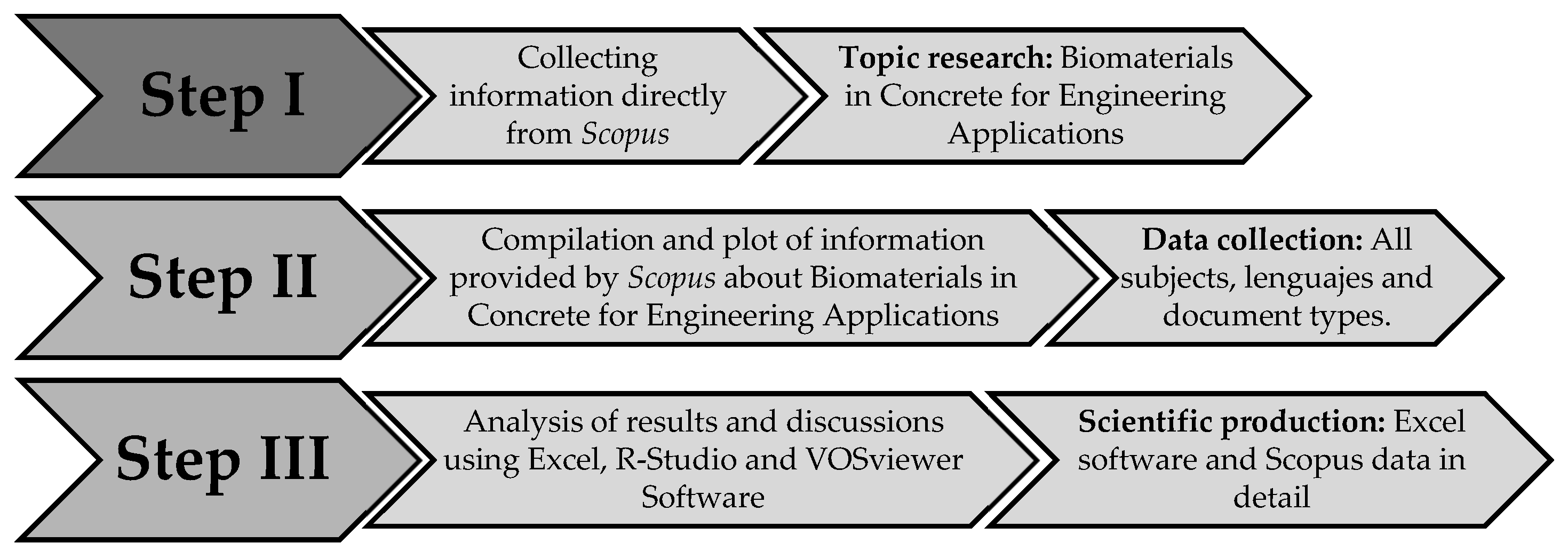
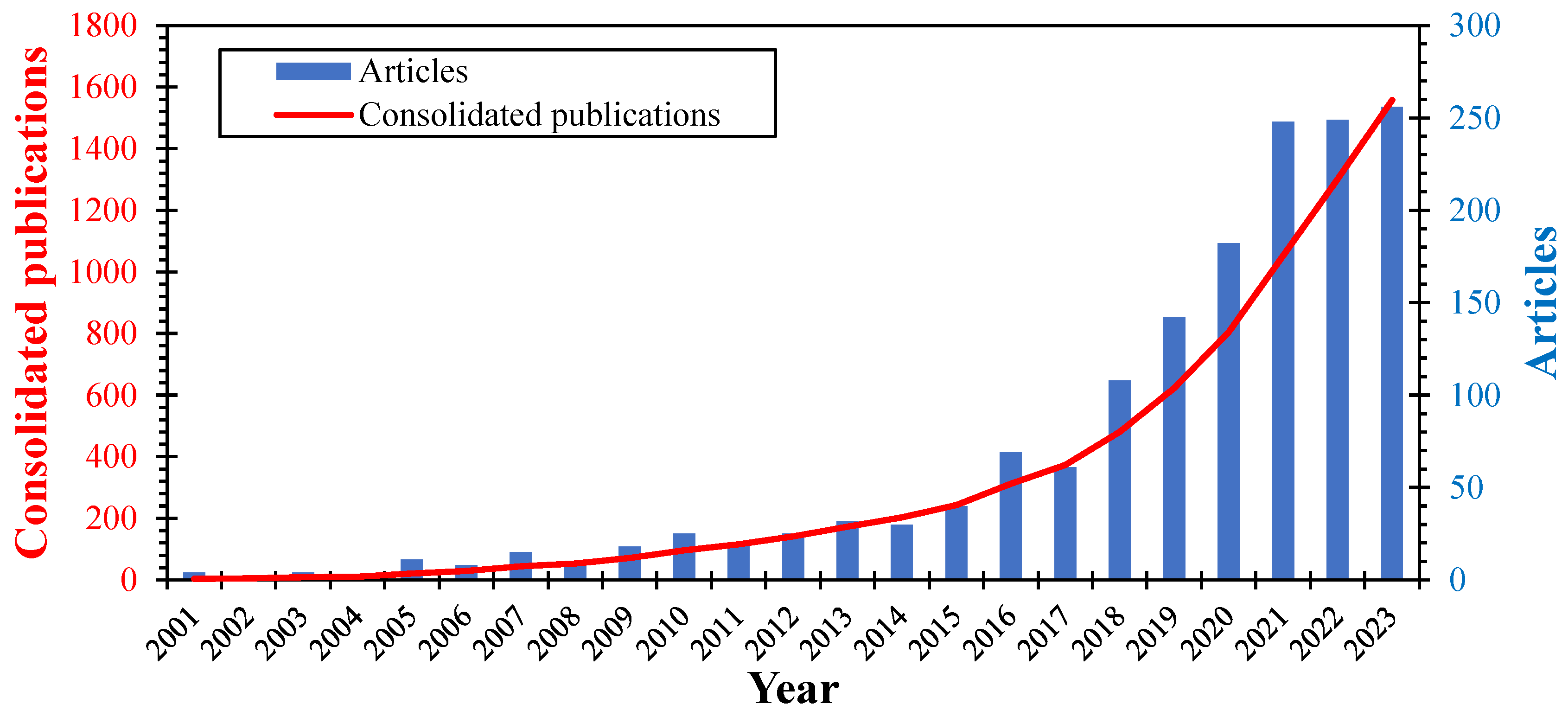



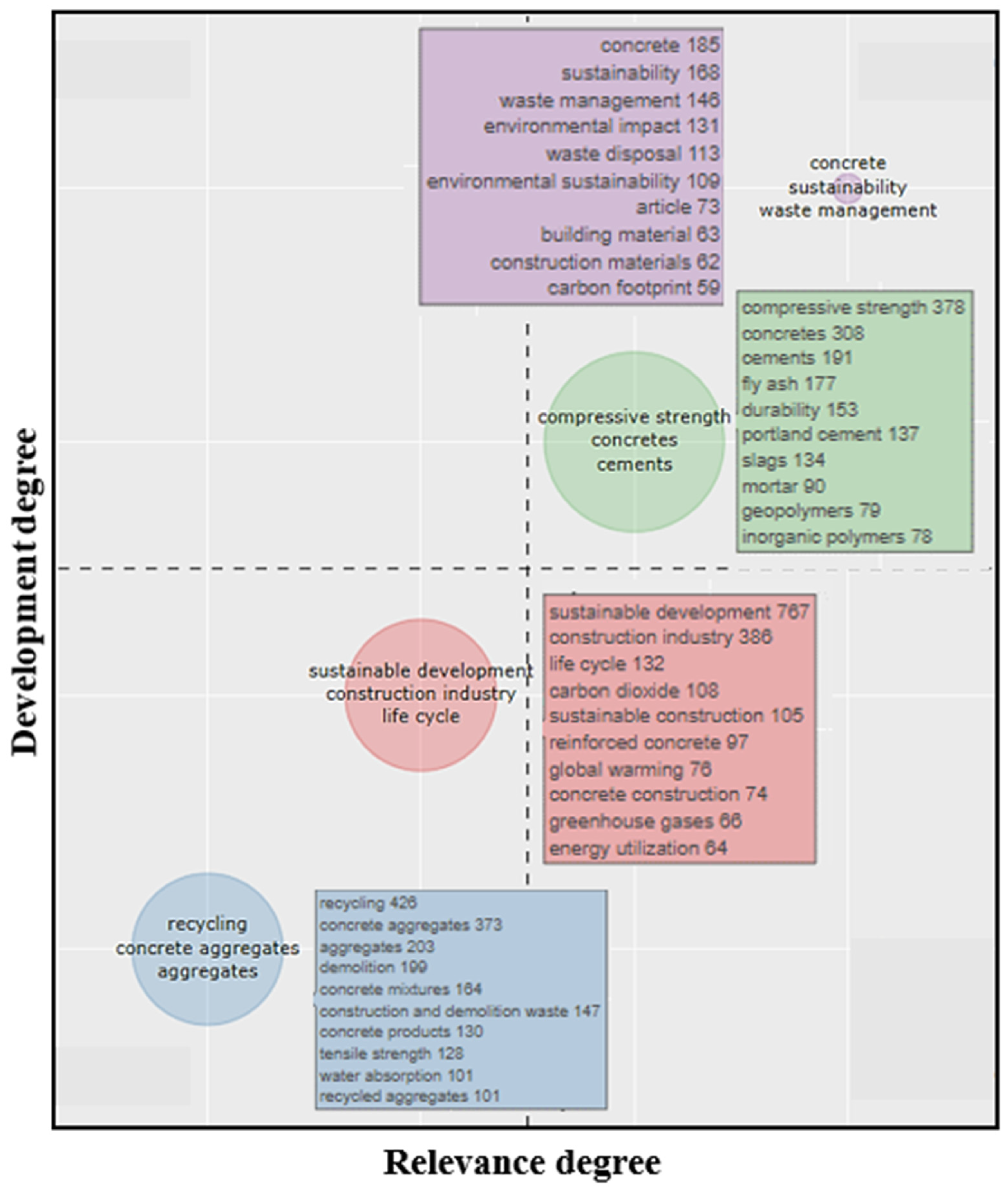

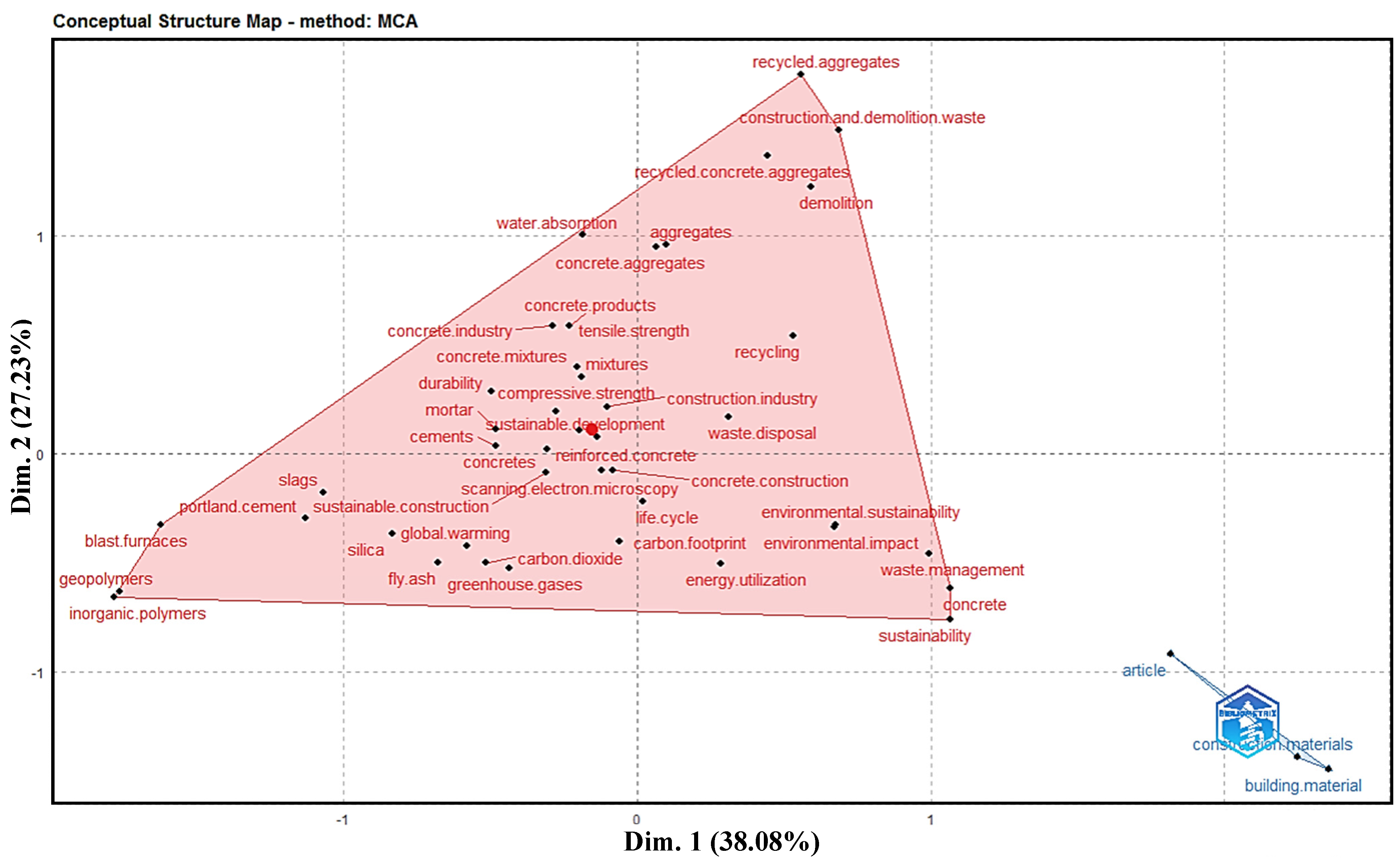






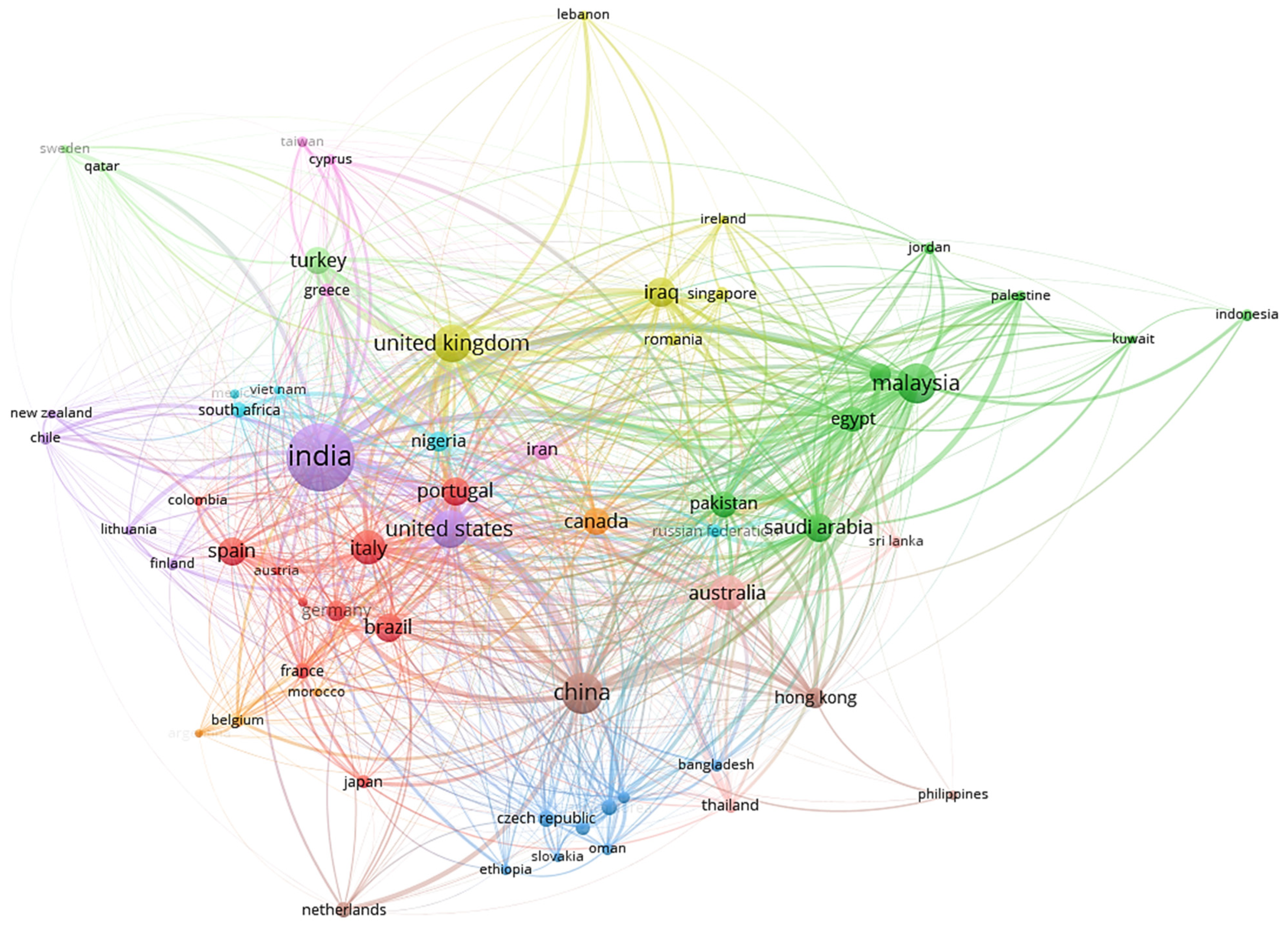
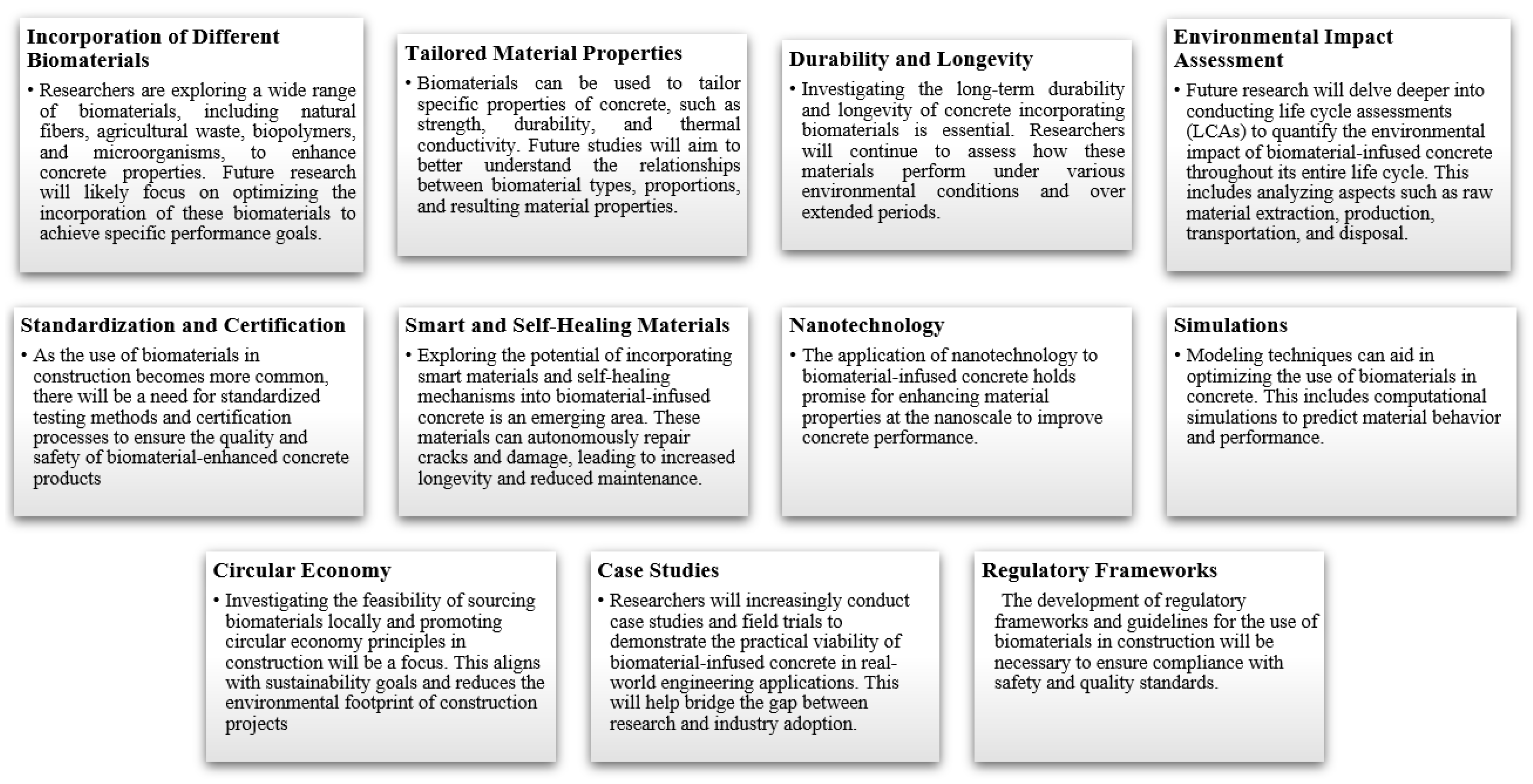
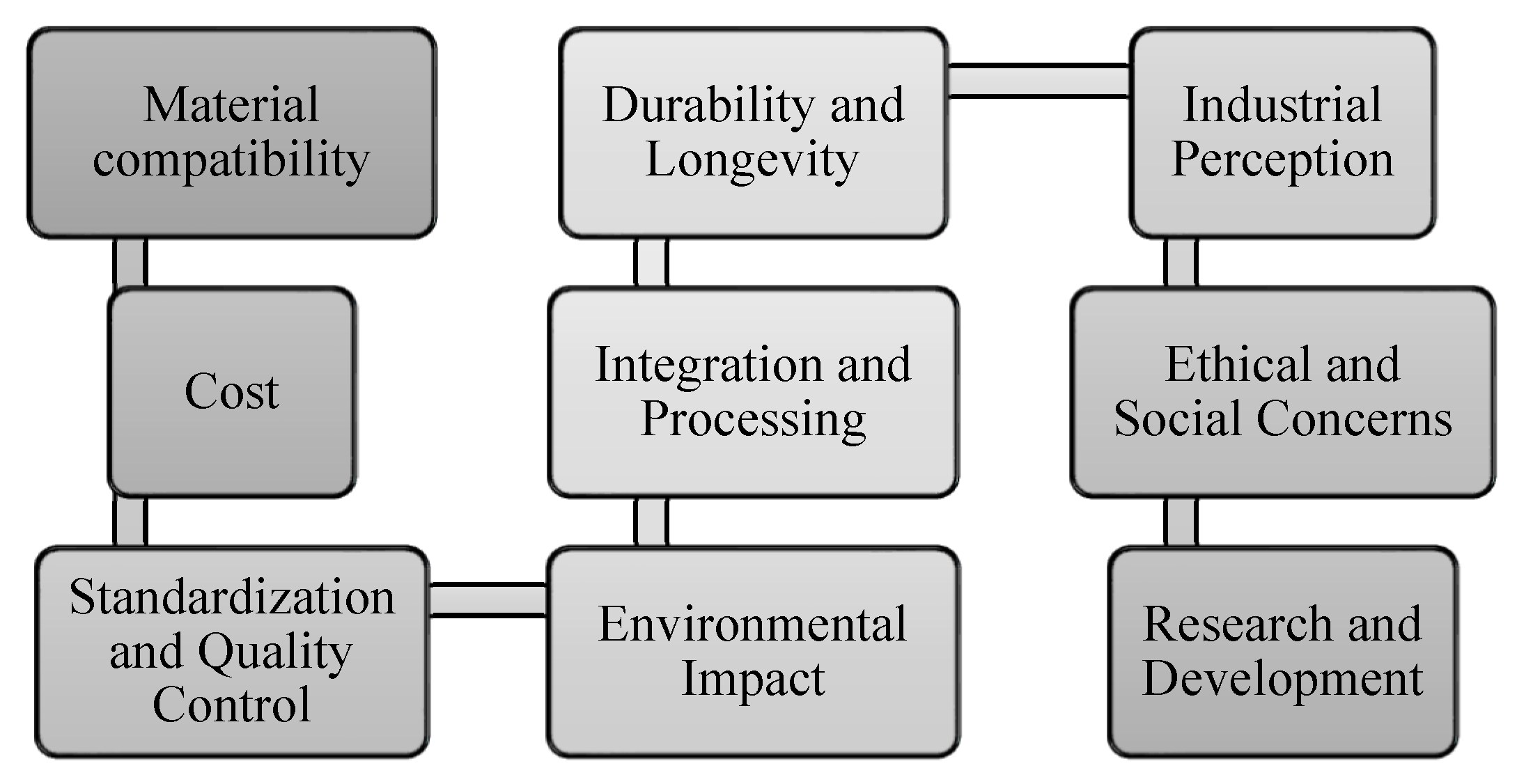
| Description | Result |
|---|---|
| Timespan | 2001 to 2023 |
| Source | 489 |
| Average years from publication | 3.96 |
| Average citations per document | 18.67 |
| Average citations per year per doc | 3.75 |
| References | 64,082 |
| Keywords Plus (ID) | 6212 |
| Author’s Keywords (DE) | 3286 |
| Document Types | |
| Article | 912 |
| Conference-paper | 385 |
| Review-article | 165 |
| Book-chapter | 85 |
| Book | 5 |
| Others | 6 |
| Authors | |
| Authors | 4521 |
| Author Appearances | 5886 |
| Authors of single-authored documents | 88 |
| Authors of multi-authored documents | 4433 |
| Single-authored documents | 95 |
| Documents per Author | 0.345 |
| Authors per Document | 2.9 |
| Co-Authors per Documents | 3.78 |
| Collaboration Index | 3.15 |
| Recyclables | Engineering Use | Biomaterials | ||||||
|---|---|---|---|---|---|---|---|---|
| Metals | Plastics | Glasses | Paper and Paperboard | Industrial Residues | ||||
| R | C | R | C | R | C | R | C | R |
| Estructures | Steel | Pipelines | PET | Windows | Tempered | Blueprints | Magazines | Coffee husk |
| Pipelines | Aluminium | Coatings | HDPE | Doors | Recycled | Packaging | Newspapers | Rice husk |
| Ductes | Cobble | Electrical components | PVC | Isolations | --- | Panelrs | Boxes | Cacao |
| Fixing elements | --- | Electronic components | LDPE | Decorative elements | --- | --- | Packaging | Farm wastes |
| Benefits of recycling | ||||||||
| 1. | Carbon emissions reduction. | |||||||
| 2. | Environmental pollution reduction. | |||||||
| 3. | Consumption reduction of natural resources. | |||||||
| 4. | Waste volume reduction in landfills. | |||||||
| 5. | Circular economy and sustainability promotion. | |||||||
| 6. | Energy saving. | |||||||
| Author | Local | Year Start | Most Relevant Document from Scopus Profile | Document Citations | ||
|---|---|---|---|---|---|---|
| h_index | TC | NP | ||||
| De Brito J | 9 | 391 | 10 | 2016 | Mechanical behaviour of concrete made with fine recycled concrete aggregates | 792 |
| Tam VWY | 8 | 1135 | 8 | 2008 | Microstructural analysis of recycled aggregate concrete produced from two-stage mixing approach | 673 |
| Adesina A | 7 | 369 | 8 | 2019 | Plastic wastes to construction products: Status, limitations and future perspective | 203 |
| Alyousef R | 7 | 473 | 8 | 2019 | Clean production and properties of geopolymer concrete: A review | 391 |
| Colangelo F | 7 | 347 | 8 | 2017 | Coal fly ash as raw material for the manufacture of geopolymer-based products | 267 |
| Mo KH | 7 | 362 | 8 | 2018 | Evaluation of thermal conductivity, mechanical and transport properties of lightweight aggregate foamed geopolymer concrete | 311 |
| Alabduljabbar H | 6 | 335 | 7 | 2019 | Properties and utilizations of waste tire rubber in concrete: A review | 206 |
| Bheel N | 6 | 117 | 8 | 2021 | Influence of coconut shell ash on workability, mechanical properties, and embodied carbon of concrete | 42 |
| Faleschini F | 6 | 231 | 6 | 2016 | Properties of concretes with black/oxidizing electric arc furnace slag aggregate | 169 |
| Farina I | 6 | 278 | 7 | 2018 | Recycled nylon fibers as cement mortar reinforcement | 164 |
| Ling T-C | 6 | 452 | 7 | 2013 | Durability of recycled aggregate concrete—A review | 455 |
| Matos AM | 6 | 509 | 7 | 2012 | One-step synthesis of dipyrromethanes in water | 101 |
| Poon CS | 6 | 502 | 7 | 2014 | Effect of microstructure of ITZ on compressive strength of concrete prepared with recycled aggregates | 753 |
| Yang J | 6 | 365 | 6 | 2020 | Concrete with recycled concrete aggregate and crushed clay bricks | 293 |
| Arulrajah A | 5 | 375 | 5 | 2018 | Geotechnical and geoenvironmental properties of recycled construction and demolition materials in pavement subbase applications | 338 |
| Cioffi R | 5 | 242 | 6 | 2017 | Recycling of MSWI fly ash by means of cementitious double step cold bonding pelletization: Technological assessment for the production of lightweight artificial aggregates | 184 |
| He Z-H | 5 | 167 | 5 | 2021 | Utilization of CO2 curing to enhance the properties of recycled aggregate and prepared concrete: A review | 216 |
| Horpibulsuk S | 5 | 375 | 5 | 2018 | Analysis of strength development in cement-stabilized silty clay from microstructural considerations | 425 |
| Jhatial AA | 5 | 69 | 5 | 2020 | Investigating embodied carbon, mechanical properties, and durability of high-performance concrete using ternary and quaternary blends of metakaolin, nano-silica, and fly ash | 32 |
| Li J | 5 | 170 | 7 | 2013 | A model for estimating construction waste generation index for building project in China | 26 |
| First Author | Journal | Year | Title | TC from Scopus | Ref. |
|---|---|---|---|---|---|
| Behera M | Constr Build Mater | 2014 | Recycled aggregate from C&D waste & its use in concrete—A breakthrough towards sustainability in construction sector: A review | 766 | [65] |
| Tam VWY | Constr Build Mater | 2018 | A review of recycled aggregate in concrete applications (2000–2017) | 610 | [66] |
| Shu X | Constr Build Mater | 2014 | Recycling of waste tire rubber in asphalt and portland cement concrete: An overview | 459 | [67] |
| Corinaldesi V | Constr Build Mater | 2009 | Influence of mineral additions on the performance of 100% recycled aggregate concrete | 402 | [68] |
| Kisku N | Constr Build Mater | 2017 | A critical review and assessment for usage of recycled aggregate as sustainable construction material | 385 | [69] |
| Part WK | Constr Build Mater | 2015 | An overview on the influence of various factors on the properties of geopolymer concrete derived from industrial by-products | 364 | [70] |
| Aye L | Energy Build | 2012 | Life cycle greenhouse gas emissions and energy analysis of prefabricated reusable building modules | 312 | [71] |
| Aprianti E | Constr Build Mater | 2015 | Supplementary cementitious materials origin from agricultural wastes—A review | 311 | [72] |
| Naik TR | Pract Period Struct Des Constr | 2008 | Sustainability of Concrete Construction | 276 | [73] |
| Aprianti S E | J Clean Prod | 2017 | A huge number of artificial waste material can be supplementary cementitious material (SCM) for concrete production—a review part II | 271 | [74] |
Disclaimer/Publisher’s Note: The statements, opinions and data contained in all publications are solely those of the individual author(s) and contributor(s) and not of MDPI and/or the editor(s). MDPI and/or the editor(s) disclaim responsibility for any injury to people or property resulting from any ideas, methods, instructions or products referred to in the content. |
© 2023 by the authors. Licensee MDPI, Basel, Switzerland. This article is an open access article distributed under the terms and conditions of the Creative Commons Attribution (CC BY) license (https://creativecommons.org/licenses/by/4.0/).
Share and Cite
Jaramillo, H.Y.; Vasco-Echeverri, O.H.; Moreno-Pacheco, L.A.; García-León, R.A. Biomaterials in Concrete for Engineering Applications: A Bibliometric Review. Infrastructures 2023, 8, 161. https://doi.org/10.3390/infrastructures8110161
Jaramillo HY, Vasco-Echeverri OH, Moreno-Pacheco LA, García-León RA. Biomaterials in Concrete for Engineering Applications: A Bibliometric Review. Infrastructures. 2023; 8(11):161. https://doi.org/10.3390/infrastructures8110161
Chicago/Turabian StyleJaramillo, Haidee Yulady, Oscar Hernan Vasco-Echeverri, Luis Alfonso Moreno-Pacheco, and Ricardo Andrés García-León. 2023. "Biomaterials in Concrete for Engineering Applications: A Bibliometric Review" Infrastructures 8, no. 11: 161. https://doi.org/10.3390/infrastructures8110161
APA StyleJaramillo, H. Y., Vasco-Echeverri, O. H., Moreno-Pacheco, L. A., & García-León, R. A. (2023). Biomaterials in Concrete for Engineering Applications: A Bibliometric Review. Infrastructures, 8(11), 161. https://doi.org/10.3390/infrastructures8110161







